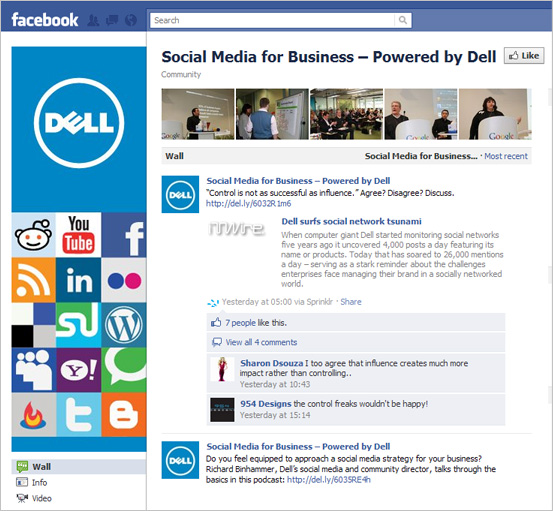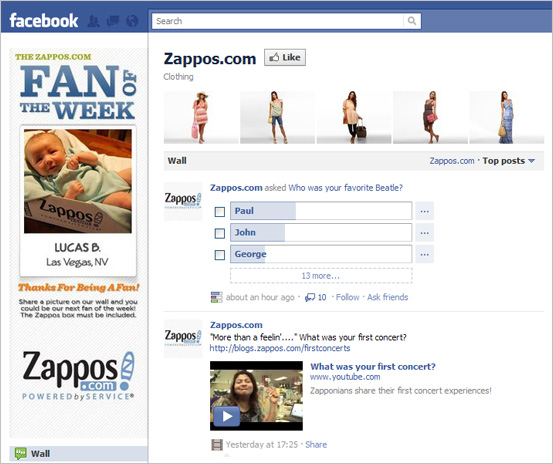How to use Facebook to market your business
Some inspiring case studies

Last modified
Facebook is one of the most effective social media tools at your disposal. Set up a Facebook fan page and you have instant access to a wide range of goodies:
- A wall to post updates and notices
- Albums to share pictures
- A video repository
- Forums to initiate conversation
- An events app with RSVP feature
- And many other free features
Not only does this allow you to share content with a global audience, it provides a platform to listen, engage and interact with customers on an intimate level.
Here are some ways you can use Facebook for business, along with inspiring case studies.
1. Share useful content
Use your wall to share valuable content with clients.
Dell’s “Social Media for Business” page is not peddling its latest products and deals, but is specifically geared to providing marketing tips for small businesses. The company found that a large portion of its user base consists of business owners grappling with "this social media thing". Consequently, they use their wall to provide links to useful articles on web marketing, initiate discussions on hot topics, share case studies and whitepaper videos, organize tweetchats, and so on. Business owners in their network receive regular bursts of ideas and inspiration:
2. Use pictures
Another way to engage users is via the use of imagery.
Steelmaster Buildings – another non-traditional user of Facebook – found that its fan base soared when they launched their photo campaign. This campaign encourages users (which include farmers and industrial users) to upload photos of their products installed on site. Competitions run seasonally and the winner of the most popular photo receives a generous gift card.
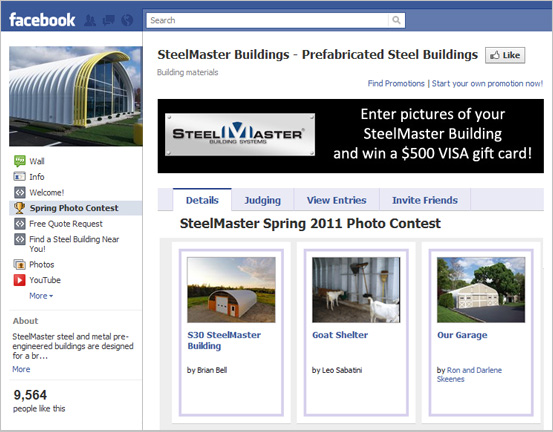 Zappos, another example, encourages users to submit fan photos and posts the winning weekly entry as their Facebook logo:
Zappos, another example, encourages users to submit fan photos and posts the winning weekly entry as their Facebook logo:
Albums can also be used to increase user engagement. Yuppiechef – an online store for innovative kitchen gear – encouraged users to share their most daring cake icing attempts in exchange for vouchers:
Their recent office move is shared in endearing story format and they regularly share pictures of hot products and enticing recipes.
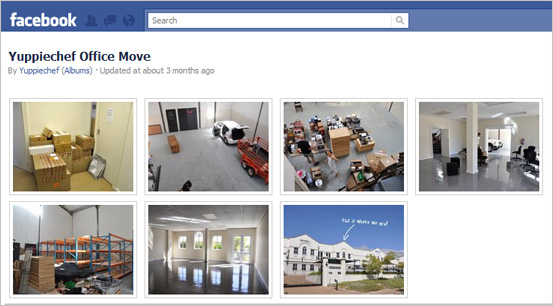 3. Run interactive campaigns
3. Run interactive campaigns
Facebook is an ideal platform to manage interactive campaigns. Nando’s Peri-Peri campaign encourages fans to upload their own endings (in text or video format) to a Nando’s ad. The ultimate winner receives an African adventure holiday.
Another example is Woolworth’s Good Food Search campaign:
 4. Promote events
4. Promote events
Events, product launches and timed promotions can be advertised via Facebook events. This provides the option for users to RSVP online and see who else is participating.
Heinz used their events feed in a very creative way to manage their "Where’s Heinz" campaign:
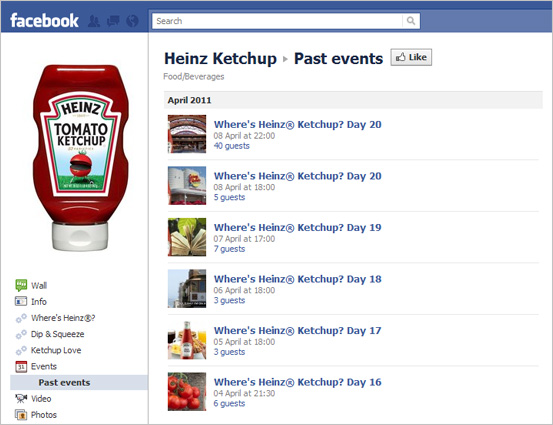
5. Create fun apps and games
If you have sufficient budget, build fun apps to spread viral awareness. This is an area where you will need to enlist the services of a web agency.
Intel created a brilliant app that allows users to create their own "Museum of Me". This app aggregates content from a user’s Facebook page to create a virtual museum of their life. View the video here.
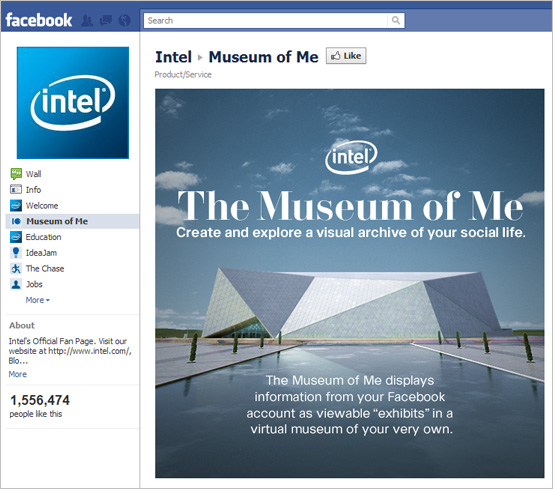
PicknPay’s Grime-o-Meter allows you to tell your friends how dirty they’d be without Handy Andy, and Google’s Doodlegram sends customized "doodle greetings" to your friends:
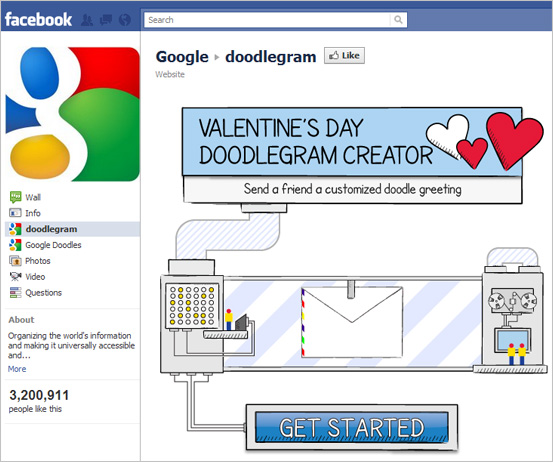
6. Share videos
On your videos page, try to stay away from promotional materials and copies of your TV ads only. Instead, post items that users will find useful or entertaining (and preferably both). Here are examples:
Intel’s video feed contains inspirational stories on how technology plays a role in people’s lives, updates on scientific discoveries and behind the scenes footage on core projects (for example, how Intel teamed up with 3D animators at Deamworks).
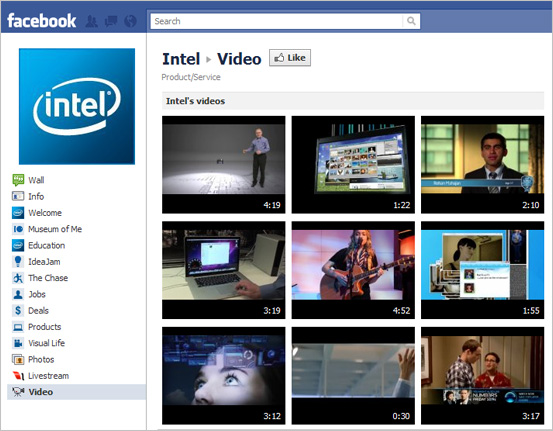
Video can cover tips, how to's, demos, reviews, recipes and tours.
Clips don’t have to be big budget affairs either. Zappos provides a great example of how informal staff-made videos can become hugely popular. Their videos cover simple yet engaging topics that resonate with the average user. These range from how moms at Zappos manage work-life balance to casual staff interviews on company values (from "doing more with less" to "having fun with a little weirdness"). They even share office pranks and random episodes on staff’s favourite items.
Videos can also be used to define the tone of a brand. Redbull's page, as an example, regularly features adventure junkies who excel at extreme sports:
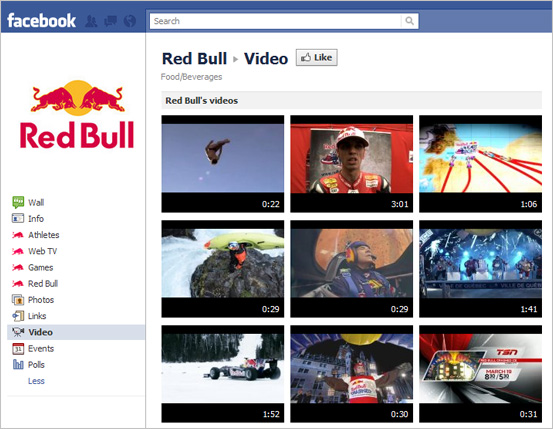
7. Post job openings
Another useful and surprisingly under-utilized feature is the ability to advertise job openings online:
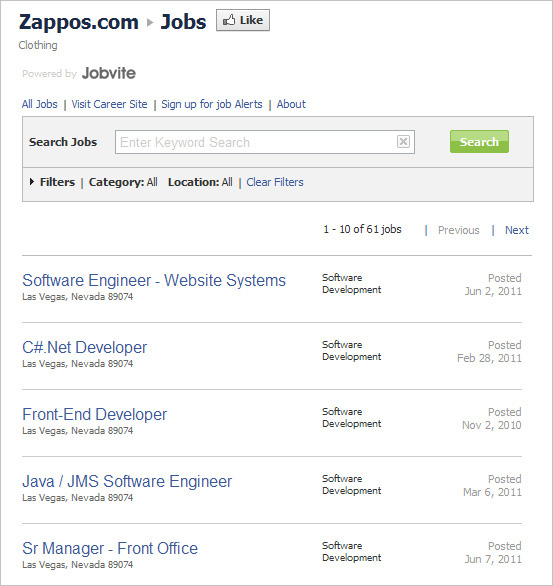 Facebook’s Marketplace can also lead to an astounding number of responses.
Facebook’s Marketplace can also lead to an astounding number of responses.
8. Use the forum
Lastly, the forum is a great place to initiate discussions and respond to fan queries.
Sony Ericsson fans use their forum to share product experiences and receive answers on technical questions (many of which are answered by community members themselves), and L'Oreal leverages their discussions page to chat about fashion tips and makeup applications:

How do I build my fan base?
Here are some quick tips:
1. Give users an incentive to join
On the launch of its Facebook page, Exclusive Books sent out a mailer where customers could win a dream holiday. To enter, they simply had to join by "liking" their Facebook page.
Other companies make certain apps or sections of their Facebook page password restricted to encourage membership:
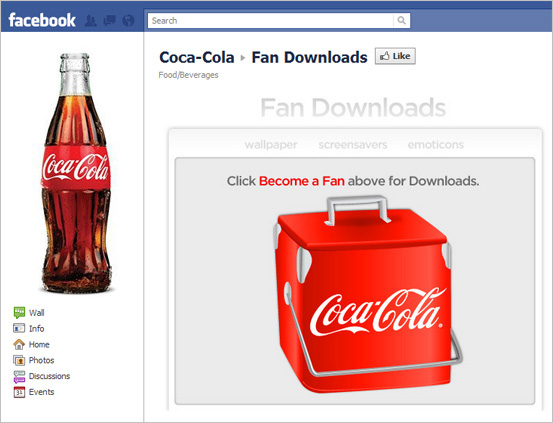
2. Embed on your site
Make sure your Facebook icon is visible on your website and, better yet, embed a Facebook feed directly on your home page:
 3. Cross-promote
3. Cross-promote
When you launch a fancy new Facebook app, tweet the link and promote it on your blog. Conversely, plug in your blog RSS feed, Flickr page and Twitter feed as tabs on your Facebook page.
4. Use your other marketing channels
Market your Facebook URL by including the address on your business cards, letterheads, electronic mailers, email signatures, skype signatures and so on. Include it in print ads and store signage, where suitable.
5. Keep updating
No one wants to join a dead Facebook page. Assign a staff member (or staff team) the responsibility to update the wall regularly and respond to comments and discussions.
Doesn’t all this require a lot of time?
The key is to focus efforts on one or two main strategies to start (whether that be videos, albums or apps). If content is useful and entertaining to your fan base, membership will grow organically.
In summary:
- Don’t simply "create and hope". Define a specific Facebook strategy from the start.
- Care about what your customers care about. Provide content that solves their problems.
- Plug in media that is entertaining and engaging.
- Be genuine and update frequently.
Share your Facebook page experiences with us below!

We specialize in web development for professional services firms. Let's discuss your next project.
